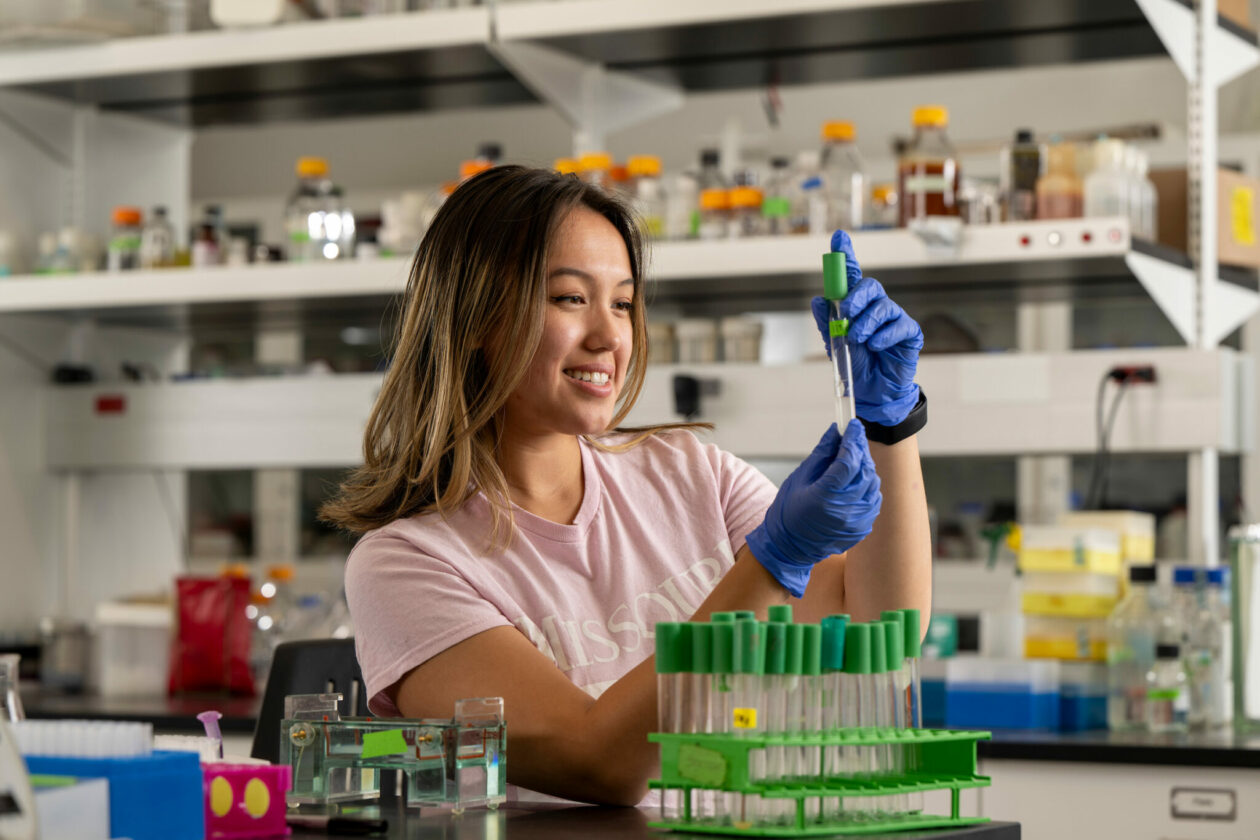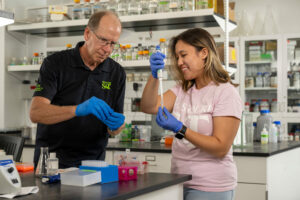What is a ‘summer break?’
Posted by Peter Ehrhard

Amelia Markwell working in a Schrenk Hall laboratory. Photo by Michael Pierce, Missouri S&T.
While the temperature soars to over 90 degrees outside, Amelia Markwell stays cool in Schrenk Hall’s biology laboratories while conducting research. This year, she’s working with a new genetic tool for sensing bacteria.
Markwell, a junior in biological sciences from Seattle, has conducted undergraduate research since she was a first-year student at Missouri S&T. She participated in the College of Arts, Sciences, and Education’s First Year Research Experience (FYRE), and has continued her work since then. In fact, the opportunity to conduct research as a freshman was one of the reasons she chose to attend S&T.
“The undergraduate research opportunities caught my eye, as this school offers a variety of majors, as well as first-year hands-on lab work,” she says.
Since those early FYRE days, Markwell has presented her research to Missouri state legislators at the University of Missouri’s Research Day at the Capital, where she presented work titled “Eavesdropping on the Microbial World: Bacterial Communication in Agriculture.”
She also participated in S&T’s Opportunities for Undergraduate Research Experiences (OURE) program, which gives students a hands-on chance to understand how research is conducted in their disciplines. This project, titled “Microbe Emulation: Cell-Cell Communication,” was a joint project with Sophia Nicolette Militante, a first-year student in biological sciences at S&T from Palo, Philippines. This project focused on different quorum-sensing positive strains in bradyrhizobium japonicum, a species of legume-root bacteria found in soybean plants across the Midwest.
The two used different chemical testing methods, such as gel electrophoresis and PCR amplification, to distinguish genetic differences between negative strains. When bacteria infect the soybeans, they leave behind nodules containing different chemical compounds, and so by studying these strains grown in Missouri and learning more about the existing bacteria, the two believe they could potentially create a drought-resistant bacteria strain.
“Soybeans are a common crop here in the state, and the B. japonicum strain of soybean is very sensitive to drought,” says Markwell. “Sophia and I worked to characterize molecules of the bean to see which strains were drought tolerant. Hopefully one day we can give recommendations to Missouri farmers on which crops will produce healthier and better yields.”

The team won first place in its science category at S&T’s Undergraduate Research Conference, and Markwell was selected as a 2024-25 OURE Fellow. Her research advisor is Dr. David Westenberg, Curators’ Distinguished Teaching Professor of biological sciences at S&T.
But despite her already prodigious research activity in biology, she hopes to move into a different field in the future – medicine. Markwell, who says she has wanted to be a doctor since she was young, is president of the university’s SCRUBS pre-medical society in preparation for applying to medical schools. She also works as a scribe in Phelps Health’s emergency medicine department.
“After graduating with my undergraduate degree, I hope to go to medical school and pursue a health-related career,” says Markwell. “While I haven’t picked a specialty quite yet, topics such as cardiology and anesthesiology definitely interest me.”
With Markwell’s future planned out, she just needs to find more time for being a student. Besides her classes and research, she also plays viola in the S&T Orchestra, is a member of the Beta Sigma Psi Lutheran fraternity on campus, and is an Opening Week student mentor – a small role that she says is one of her favorite things about campus.
“My best experience at S&T so far would have to be when I was an Opening Week mentor in 2023 for incoming freshmen,” says Markwell. “It was so rewarding getting to work with new students as they would ask me questions about classes and my extracurriculars. Getting to show them around campus and give them advice on how to be an S&T student was a great experience. I still keep in touch with most of my mentees and plan on being a mentor again next school year!”
Leave a Reply